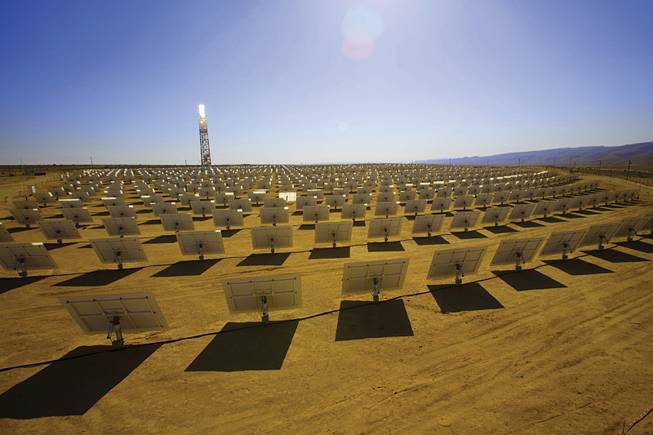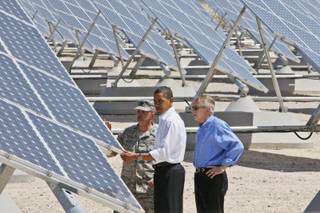
BrightSource Energy
Tuesday, July 7, 2009 | 2 a.m.
Sun Archives
- Salazar, Reid announce public lands initiative in Vegas (6-29-09)
- Editorial: Flying solar in Nevada (6-24-2009)
- NV Energy to buy power from Searchlight solar plant (6-11-2009)
- Editorial: Lessons from Nellis (6-5-2009)
- Letter to the Editor: Harnessing the sun (5-28-2009)
- Obama here for the sunshine (5-28-2009)
- Editorial: Energy and security (5-25-2009)
Sun Coverage
Sunny Forecast
Solar energy advocates forecast a sunny outlook for Nevada jobs. In Business talks with Nevada Conservation League Executive Director Scot Rutledge. Plus, Nevada casinos take another financial beating in July.
Framed by his cowboy hat under a canopy of solar panels at UNLV last week, Interior Secretary Ken Salazar declared the era of solar power in the West upon us.
“I would hope that when people look back in the year 2020 at this announcement here in 2009, they will see this as a true milestone moving us forward to the renewable energy future, to energy independence, environmental security and jobs, jobs, jobs,” Salazar said. Toward that end, he announced new Interior Department plans to speed the process of granting permits to build solar projects on federal land.
Standing in the UNLV journalism school courtyard next to Senate Majority Leader Harry Reid of Nevada, Salazar called his expectations “bold but achievable:” 13 large-scale commercial solar plants under construction in the West by the end of 2010, creating 50,000 jobs.
Getting there would be a giant leap. Solar developers complain about a slow and cumbersome process for winning approval to build big solar plants on federal land —and the federal government controls 87 percent of the land in Nevada.
Only two Nevada projects have received the go-ahead to even start the Bureau of Land Management’s environmental review process — and that came just last week. Salazar and Reid pledged to change that.
Salazar said Interior is setting aside 24 parcels of federal land in western states -- seven in Nevada -- for a special study of environmental effects. Those areas, a total of 670,000 acres, were chosen based on the routes of transmission lines and early indications that they are less environmentally sensitive than other areas.
Once an area wins preapproval, applications for solar plants could race through the process, officials say.
“Now you can do a solar project without the bureaucracy,” Reid said.
The idea is ambitious and Salazar’s timeline is aggressive. But can major projects be under way in Nevada by 2010?
A spokeswoman for the BLM in Nevada said she expects studies for the 24 special solar areas to take two years. Reviews for new applications in those zones wouldn’t begin until that process is complete, JoLynn Worley said.
On the other hand, with the urging of the Obama administration, there’s always the chance this process will be faster than the norm, she said.
Interior is pouring in resources that include opening a renewable energy office in Nevada to help speed solar construction. And because those zones are considered less ecologically sensitive, environmental reviews could move more swiftly.
Even so, other complications have arisen.
After the Salazar-Reid news conference Friday, Nellis Air Force Base Commander Howard Belote joined Worley in examining the giant cardboard map of federal solar zones in Nevada. Nearly all of them lie within 25 miles of the military’s 2.9 million acre Test and Training Range, an area as big as Maryland. A few of the zones lie in areas where radar systems could be disrupted by a solar plant with a tall tower.
Belote had anticipated this.
Obama Speaks At Nellis
President Barack Obama delivers remarks about solar energy and the economy at Nellis Air Force Base in Las Vegas.
Six weeks ago, as he gave President Barack Obama a tour of Nellis’ 14 megawatt photovoltaic solar array, he said the military needed more of a voice in the administration’s solar planning.
The biggest concern is an emerging technology that uses a tall tower to concentrate heat. A tower could disrupt radar systems if installed in some places within 100 miles north and west of the site.
Solar tower plants, which have yet to be built in the United States, use an array of mirrors to focus heat onto a single point — a tower that stands up to 600 feet tall. That heat is used to create steam to power a turbine.
Current solar plants in the United States use either photovoltaic solar arrays to create electricity directly from light, or mirror troughs to heat a liquid that travels through pipes around the plant.
Companies that developed the tower technology say it is more efficient and cheaper than other systems.
In Nevada, at least two companies have proposed sites with tall towers — SolarReserve near Tonopah and BrightSource Energy near Primm and on private property at Coyote Springs.
Nellis and SolarReserve recently tussled publicly and loudly over the company’s Tonopah area plant. SolarReserve chose the site because it is near power lines. The company says the locations the military prefers would take much longer to develop.
SolarReserve’s 600-foot tower would contain molten salt heated by the mirrors. Unlike many other solar systems, which can generate electricity only when the sun is shining, that system would allow the company to provide power 24 hours a day.
The plant, about 25 miles from the testing range, would cost $700 million and produce about 200 megawatts of power at any given time, or 75 megawatts if providing power throughout the day and night.
“If there’s anything we’re doing that’s going to cause degradation to the base, obviously none of us want to do that,” said Terry Murphy, founder and president of SolarReserve.
Murphy said he is conducting his own study of the effects on radar and believes they are minimal because the tower is shielded by a mountain range.
But Belote says military missions could be threatened by background noise created by a tower, which could interfere with messages and put U.S. forces in danger. Nellis personnel play a role in communicating with battlefield operations abroad.
The military has commissioned scientists from MIT to study the issue much more closely and come up with a more nuanced map that could tell developers exactly what type of technology would work in different spots.
The base intends to issue documents that welcome towers less than 50 feet tall and solar plants using low-lying trough and photovoltaic technology.
Nonetheless, it’s likely SolarReserve’s won’t be the only plant to receive some push-back from the military.
Belote said he’s concerned about BrightSource’s 600 megawatt proposal in Coyote Springs, which is on private land. BrightSource spokesman Keely Wachs said the company is talking with the military and is confident the two sides can work things out.


Join the Discussion:
Check this out for a full explanation of our conversion to the LiveFyre commenting system and instructions on how to sign up for an account.
Full comments policy